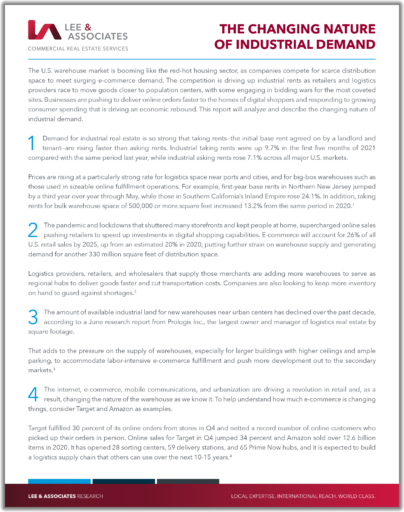The U.S. warehouse market is booming like the red-hot housing sector, as companies compete for scarce distribution space to meet surging e-commerce demand. The competition is driving up industrial rents as retailers and logistics providers race to move goods closer to population centers, with some engaging in bidding wars for the most coveted sites. Businesses are pushing to deliver online orders faster to the homes of digital shoppers and responding to growing consumer spending that is driving an economic rebound. This report will analyze and describe the changing nature of industrial demand.
1 Demand for industrial real estate is so strong that taking rents—the initial base rent agreed on by a landlord and tenant—are rising faster than asking rents. Industrial taking rents were up 9.7% in the first five months of 2021 compared with the same period last year, while industrial asking rents rose 7.1% across all major U.S. markets.
Prices are rising at a particularly strong rate for logistics space near ports and cities, and for big-box warehouses such as those used in sizeable online fulfillment operations. For example, first-year base rents in Northern New Jersey jumped by a third year-over-year through May, while those in Southern California’s Inland Empire rose 24.1%. In addition, taking rents for bulk warehouse space of 500,000 or more square feet increased 13.2% from the same period in 2020.1
2 The pandemic and lockdowns that shuttered many storefronts and kept people at home, supercharged online sales pushing retailers to speed up investments in digital shopping capabilities. E-commerce will account for 26% of all U.S. retail sales by 2025, up from an estimated 20% in 2020, putting further strain on warehouse supply and generating demand for another 330 million square feet of distribution space.
Logistics providers, retailers, and wholesalers that supply those merchants are adding more warehouses to serve as regional hubs to deliver goods faster and cut transportation costs. Companies are also looking to keep more inventory on hand to guard against shortages.2
3 The amount of available industrial land for new warehouses near urban centers has declined over the past decade, according to a June research report from Prologis Inc., the largest owner and manager of logistics real estate by square footage.
That adds to the pressure on the supply of warehouses, especially for larger buildings with higher ceilings and ample parking, to accommodate labor-intensive e-commerce fulfillment and push more development out to the secondary markets.3
4 The internet, e-commerce, mobile communications, and urbanization are driving a revolution in retail and, as a result, changing the nature of the warehouse as we know it. To help understand how much e-commerce is changing things, consider Target and Amazon as examples.
Target fulfilled 30 percent of its online orders from stores in Q4 and netted a record number of online customers who picked up their orders in person. Online sales for Target in Q4 jumped 34 percent and Amazon sold over 12.6 billion items in 2020. It has opened 28 sorting centers, 59 delivery stations, and 65 Prime Now hubs, and it is expected to build a logistics supply chain that others can use over the next 10-15 years.4
5 All of this e-commerce activity is causing tremendous demand for infill locations for last-mile distribution centers. Infill facilities are smaller fulfillment centers built in dense urban areas filled only with the best-selling items. Infill facilities support the delivery of goods to customers who want one-hour and two-hour delivery timeframes. Infill land is located in a city and has usually been developed but is now vacant and can be re-purposed for new users.
6 As a general rule of thumb, “last-mile” refers to the last point of distribution or sortation to the final destination of a home or business. However, different companies have different definitions of “last-mile”. For Walmart, it means order today, receive shipment tomorrow, second day or three-to-five day delivery depending on final delivery zip code. However, for Amazon, it means within 2-4 hours and next day equals order by midnight, get it by noon-5 next day. For most others, it means order by noon, delivery today before 8 PM. READ MORE >


